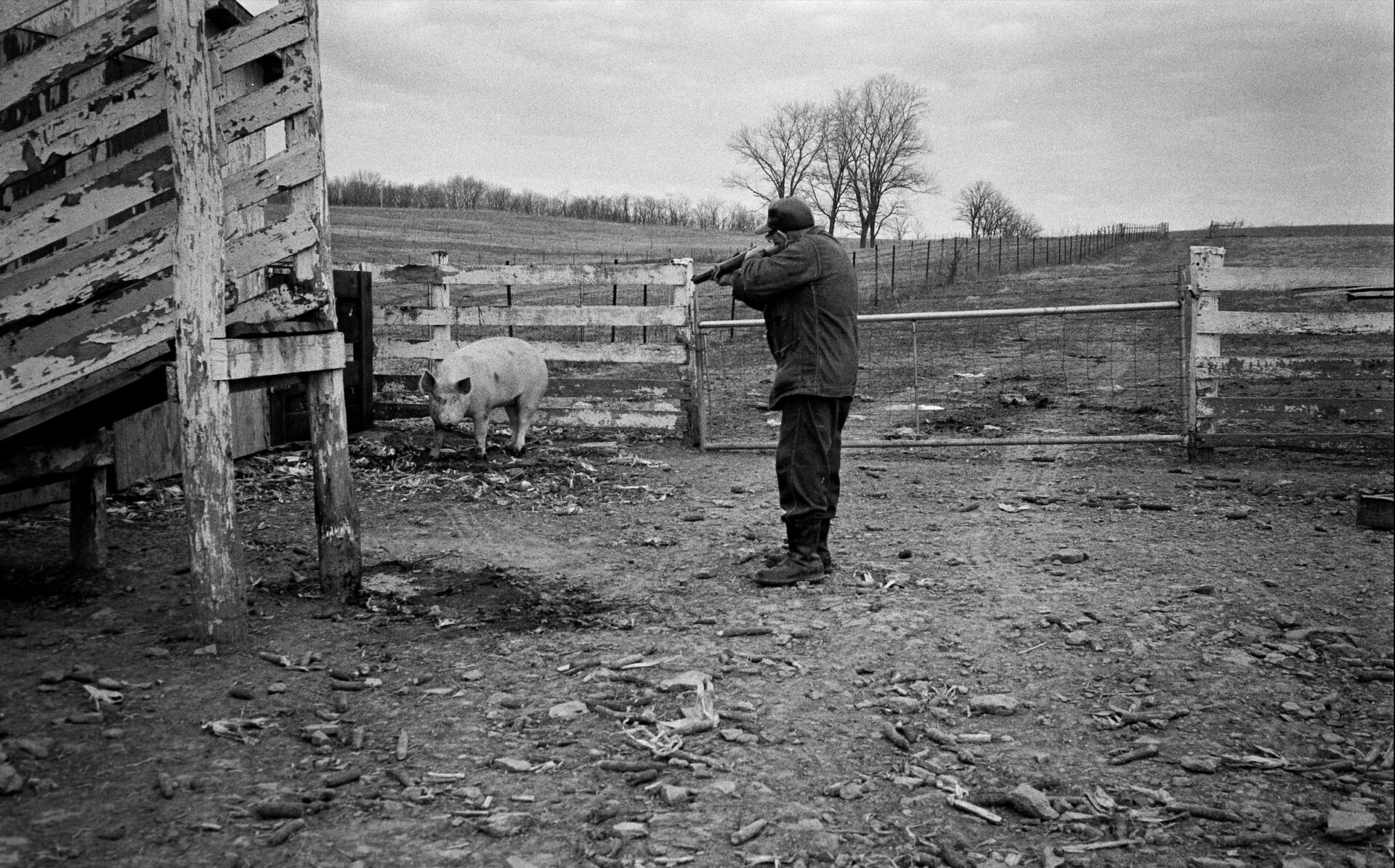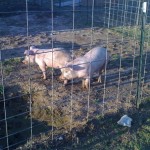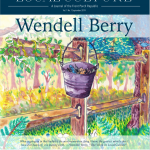Stoughton, WI. This winter, the University of Kentucky Press published a slim book of photographs by Tanya Amyx Berry under the title For the Hog Killing, 1979. After an essay and a poem by Berry’s husband Wendell, the book opens with a photograph called “Careful Marksman 1” that spreads across two full pages. In the center of the frame, a man aims a Mossberg .22 rifle at a hog that he has driven into a corner of the barnyard. Vertical fenceposts and the marksman’s body hem the pig in and frame it as the photograph’s subject. Horizontal fence rails and the farmer’s shogun barrel lead our eyes to it. The hog’s head is slightly bowed, but not in submission. Its right foreleg is slightly splayed and tense, ready to propel the cornered animal into the gap between the fence and the farmer. As the hog eyes the opening it also looks directly at the lens of Berry’s camera—and right into the viewer’s eyes—in this instant before its death.
After this arresting opening image, the next several photographs present a sort of stop-motion animation of the moments right at and then after the hog’s death: the hog turning to face the rifle, the shooter and two other men working on the hog with upturned legs the moment after it fell, the hog being moved with the bucket of a John Deere tractor, the hog being sprayed down with a garden hose, and then the hog being tipped into a tub of scalding water. As the process unfolds, and as the hog is transformed into pork, the focus of Berry’s photographs gradually shifts from the animals that are being killed to the farmers who undertake the work. The result is a carefully composed, exposed, and selected photo-essay. As I looked at the photographs again and again, though, I struggled to understand what they meant, and I wondered what I was supposed to do with forty-eight pictures of Wendell Berry and his friends killing, butchering, and eating hogs.
Tanya Berry’s photographs are not the first pictures I have seen of animal slaughter, but the other pictures I’ve seen haven’t presented me with nearly the conundrum that Berry’s do. I saw some of my first images of animal slaughter one sunny afternoon midway across the quad at the University of Minnesota when an earnest young man sporting dreadlocks, hemp jewelry, and a tie-dye shirt handed me a glossy pamphlet filled with grainy, flash-blown color photographs of animal mistreatment in some industrial abattoir. I was so shocked by the pictures that I barely heard the young man’s pitch about vegetarianism and animal rights. When he finished speaking, I thanked him for his advocacy, folded the pamphlet, tucked it into my back pocket, and continued on my way to the library. Weeks later, standing before an open washing machine, I found the crinkled pamphlet in my jeans and tossed it away without unfolding it.
A few years later, my in-laws gave me Hugh Fearnley-Whittingstall’s The River Cottage Meat Book for Christmas. I flipped through the book while my kids opened presents, and there, next to the Christmas tree, I stumbled upon the book’s series of ten photographs by Simon Wheeler that document the slaughter of two of Fearnley-Whittingstall’s North Devon steers. Except for one picture of Fearnley-Whittingstall loading his animals onto a trailer in his green field, all the photographs document a cold, efficient process undertaken by white-jacketed butchers in a sterile, fluorescent lit processing plant. Fearnley-Whittingstall explains that he includes the slaughter pictures in his meat cookbook to “remind all carnivores that there is no meat without the death of some warm-blooded, sentient animal—and that those who eat meat must take responsibility for those deaths.” He also includes the photographs to challenge vegetarians ethically opposed to animal slaughter to consider what kind of life and death would be more humane for these two particular animals. Though The River Cottage Meat Book’s photographs were published for a reason almost directly opposed to the animal rights organization’s, they had a similar effect on me. That is to say, they had very little effect. Mere minutes after Wheeler’s photographs arrested my attention, I ate the standing rib roast my father-in-law served for Christmas dinner and gave hardly a thought to its provenance.
My failure to be moved by the photographs of slaughter is not unique. Susie Linfield observes in her essay “A Little History of Photography Criticism; or Why Do Photography Critics Hate Photography?” that critics have long argued that photographs don’t really have any power at all. As an example, Linfield quotes Alan Sekula, who declares that documentary photography has “contributed much to spectacle, to retinal excitation, to voyeurism, to terror, envy, and nostalgia, and only a little to the critical understanding of the social world.” As often as critics dismiss photography as ineffective, though, Linfield observes that they also fret that photographs have too much power. Because photographs can offer such “immediate, viscerally emotional connection to the world” critics following Bertoldt Brecht and Sigfried Kracauer worry that they could easily overwhelm our reasoned judgments of the world. Brecht responded to photography’s raw and dangerous emotional power, Linfield notes, by rigorously and relentlessly distancing himself with suspicion, irony, and the “armor of ideology.” Generations of photography critics have followed his lead. The consequence of all this critical suspicion, according to Linfield, is that we have become so proficient at separating ourselves from photographs that we have lost the capacity to respond to them. This need not be the case though. Near the end of her essay, Linfield wonders hopefully, “Can photography itself make the world more livable? Can it justify its claims to give a voice to the silent and expose the plight of the powerless? Can it act as a connective tissue between different, even antagonistic cultures; can it illuminate the dark?” She concludes that if we “integrate emotion into the experience of looking” at photographs, they can help us delve into “the fullness of the world outside ourselves.”
If art critics are as distant from and as suspicious of photographs as Linfield maintains, they are probably doubly removed and twice as suspicious of photographs of rural Americans and agricultural activities like hog slaughter. In The Left Behind, sociologist of rural America Robert Wuthnow observes the tendency of scholars, critics, and pundits to opine about rural people’s lives from a distance without spending much time talking directly to them. The result, according to Wuthnow, is a one-dimensional presentation of rural life that vacillates between romanticized descriptions of rustic life and “caustic criticisms of backward voters in rural areas . . . intent upon impeding urban progress.” Tanya Berry’s editor Ben Aguilar makes a related observation at the end of For the Hog Killing, 1979 when he notes that the “most iconic renderings of agrarian existence [emphasize] the poverty and immiseration visited on agrarian people.” Iconic Depression-era Farm Security Administration photographs like Dorothea Lange’s “Migrant Mother” on the one hand and nostalgic landscape pictures of red barns, windmills, and split-rail fences on the other, both fail to give a picture of what Aguilar characterizes as a “functioning agricultural community engaged in mutual support as viewed from within.”
Tanya Berry’s photographs do provide this internal view, though she doesn’t state a rhetorical purpose for her photographs, much less does she seek to evoke a specific, predetermined emotional response. In her “Artist Statement,” Berry writes that she simply “took photographs to document the event” of hog-killing that she had previously participated in for many years. Aguilar attests to Berry’s documentary purpose when he explains, “These images, along with many others, were originally captured by Tanya for potential publication in Rodale Press’s New Farm magazine for which her husband, Wendell Berry, was doing some writing at the time. The magazine’s editors sent along a camera, figuring that having Tanya follow him around taking snapshots would be cheaper than flying a staff photographer out every month.”
As interesting a glimpse into late-1970s rural life as the photographs are, it would be a mistake to regard them only as snapshots, illustrations, or historical artifacts. Berry herself modestly describes the photographs as a “form of art,” and Aguilar encourages us to consider them alongside the fine art of Dorothea Lange, Walker Evans, and Alan Lomax. The particular form of art that Berry has in mind has more to do with traditional handcraft, though, than something that might be matted, framed, and hung on white gallery walls. Berry understands her photographic art to be literally continuous with the art of hog killing: “my participation,” she writes, “shifted from one form of art to another.” In the book’s introduction, Berry’s husband Wendell similarly connects fine photographic art to “the traditional art of hog killing.” According to Wendell Berry, artful hog killing is distinguished by the killer’s ability to “perform well under . . . pressure” without making “a shameful mess.”
Wendell Berry’s earlier reflections on photography provide some insight into how a photographer (and a photographic critic) might avoid “making a shameful mess” of a complex reality. In The Unforeseen Wilderness—published ten years before Tanya Berry took the For the Hog Killing, 1979 photographs—Wendell Berry distinguishes between a “tourist-photographer” and the “photographic artist.” The “tourist-photographer,” Wendell Berry writes, “goes to a place, bound by his intentions and preconceptions, to record what has already been recorded and what he therefore expects to find.” The “photographic artist,” in contrast, embarks on a “pilgrimage, for he [or in this case she] goes along ways he does not fully understand, in search of what he does not expect and cannot fully anticipate. His undertaking involves a profound humility, for he has effaced himself; he has done away with his expectations; he has ceased to make demands upon the place.” Wendell Berry describes the ideal photographer’s posture towards his or her subject, but we might also think of this posture as a better way to look at photographs as well. If we can approach Tanya Berry’s photographs without the anticipation and expectation that Wendell Berry warns us about, and if we can as Linfield encourages, “integrate emotion into the experience of looking,” perhaps we can encounter the photographs of For the Hog Killing, 1979 not as mere “ornaments or relics,” as Wendell Berry writes in The Unforeseen Wilderness, “but as windows and doors, enlargements of our living space, entrances into the mysterious world outside the walls, lessons in what to look for and how to see.”
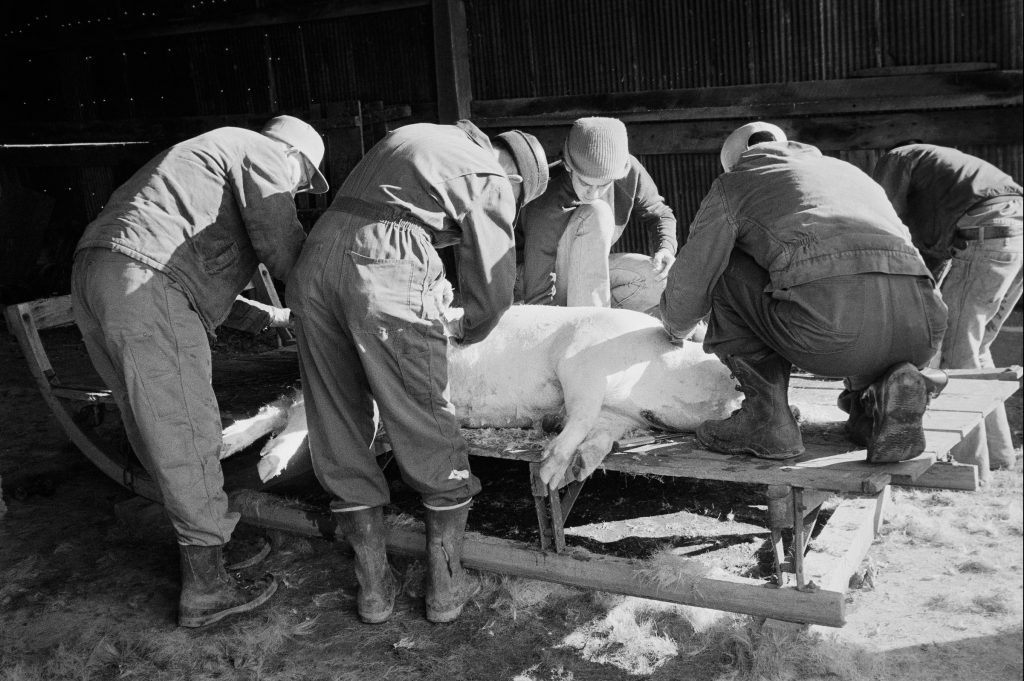
The best of Berry’s photographs in For the Hog Killing, 1979 go beyond documenting a healthy agricultural community from the past; they invite viewers to imagine themselves participating in that community. The book’s titular photograph, “For the Hog Killing,” is one obvious example. In the picture, four men lean over a hog in slanting afternoon sunlight. They work on different parts of the hog, but they work in concert, their rounded backs and bent arms forming concentric arcs of attention. One of the men has stepped away from the hog to work on some parallel task in the background, and this man’s absence leaves just enough room for some viewers to see themselves joining the work on the hog’s foreleg.
Berry’s photograph “Loyce’s Kitchen” similarly invites viewers into the community of neighbors and friends who have gathered to work together. The photograph shows five men and three women sitting around a dinner table eating the pork they have butchered. Unlike Grant Wood’s famous painting “Dinner for Threshers” which slices the fourth wall off a farmhouse to present farmworkers as stylized farmer-types of uniform height, dress, and haircut in a kind of diagrammatic tableau, Berry’s tight shot places us in the midst of a small community of individual people. As many art historians have observed, Grant Wood painted “Dinner for Threshers” in 1934, but the scene of the painting is far more representative of farm life in 1892—the year painted on the barn in the background—than Wood’s contemporary context. Whereas Wood’s painting inspires nostalgia for an idealized pastoral age that had been lost, Berry’s art can inspire us to conserve, resurrect, and grow the ordinary practices—working together, eating together, helping our neighbors, and welcoming each other—that maintain the health of communities.
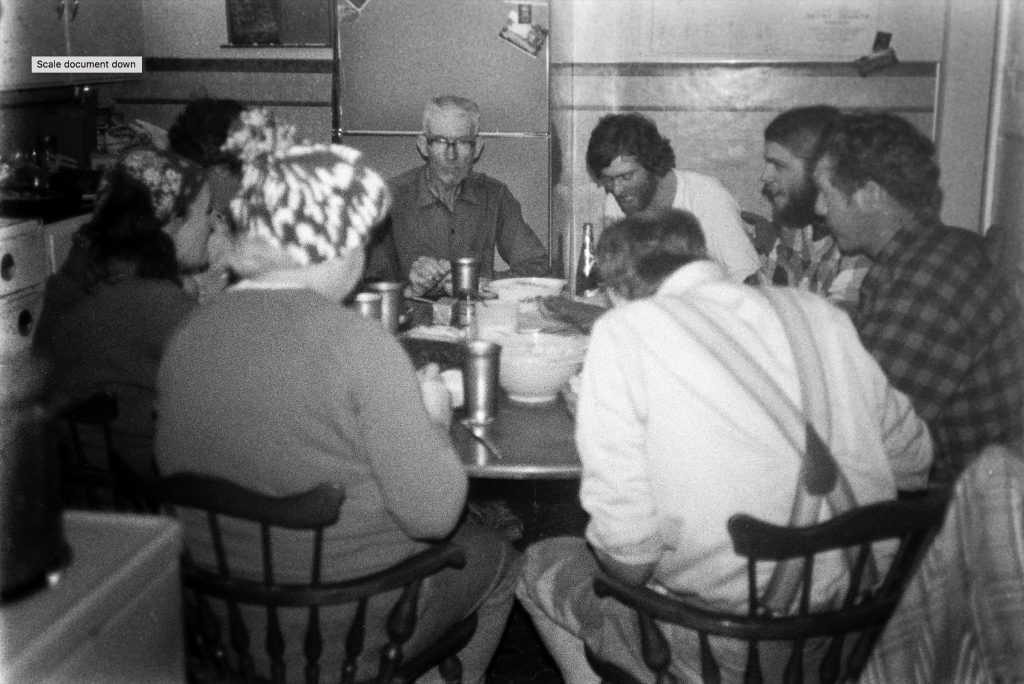
It is, of course, relatively easy for me, a white man who happens to own a farm and be a professor of English, to imagine myself pulling up a chair to join the dinner at Loyce’s table. And like the many Front Porch Republic readers who admire Tanya and Wendell Berry’s life and art, who live in close proximity to fields and livestock, and who have experimented with growing and processing their own food, I don’t have to strip off all that much ideological armor or close too much critical distance to see myself joining the tight-knit group of friends to work on a hog’s foreleg. In this moment of reckoning with the social distance and injustice brought to the fore of our national consciousness by the twin tragedies of a pandemic (that disproportionately affects African American men and women) and the murder of George Floyd it is worth reflecting on how open we imagine our invitations to community to be.
Perhaps the experience of opening ourselves up to Berry’s photographs of a healthy community can prepare us to look more carefully and openheartedly at photographs of broken communities like the ones that Richard Wright includes in his book 12 Million Black Voices (1941). Wright’s long essay describes African American migration from the rural, Jim Crowe South, to segregated northern cities and is illustrated with photographs by the very same Farm Security Administration photographers–Dorothea Lange, Arthur Rothstein, and Walker Evans, among others—whose photographs of poor white farmers during the Great Depression have become icons of agricultural struggle.
I had read 12 Million Black Voices many years ago, but I returned to it this past week after I saw pictures of thousands of Americans in cities and small towns marching and protesting against systemic racism and injustice. In the middle of the book, a series of photographs shows black sharecroppers or day laborers planting, cultivating, and harvesting cotton. The six images struck me as a negative of the traditional art Berry offers in For the Hog Killing, 1979. Unlike Berry’s photographs of communal labor in For the Hog Killing, 1979, Wright shows individual sharecroppers working in isolation, separated not only from their neighbors, but also members of their own families. “Our lives are walled with cotton,” Wright captions the first two photographs by Dorothea Lange. The first of these photographs is of cotton fields with two or three miniscule figures walking a narrow road, and the second is of a solitary, silhouetted sharecropper plowing behind a mule. A ridge rises up behind him like a hedge or a boundary wall. In Lange’s “Hoeing Cotton, Alabama,” rows of cotton separate members of a family from each other in parallel but separate labors. Ben Shahn’s “Cotton Pickers, Arkansas” on the facing page similarly shows farm workers’ attention directed away from each other as they pick the landowners crop.
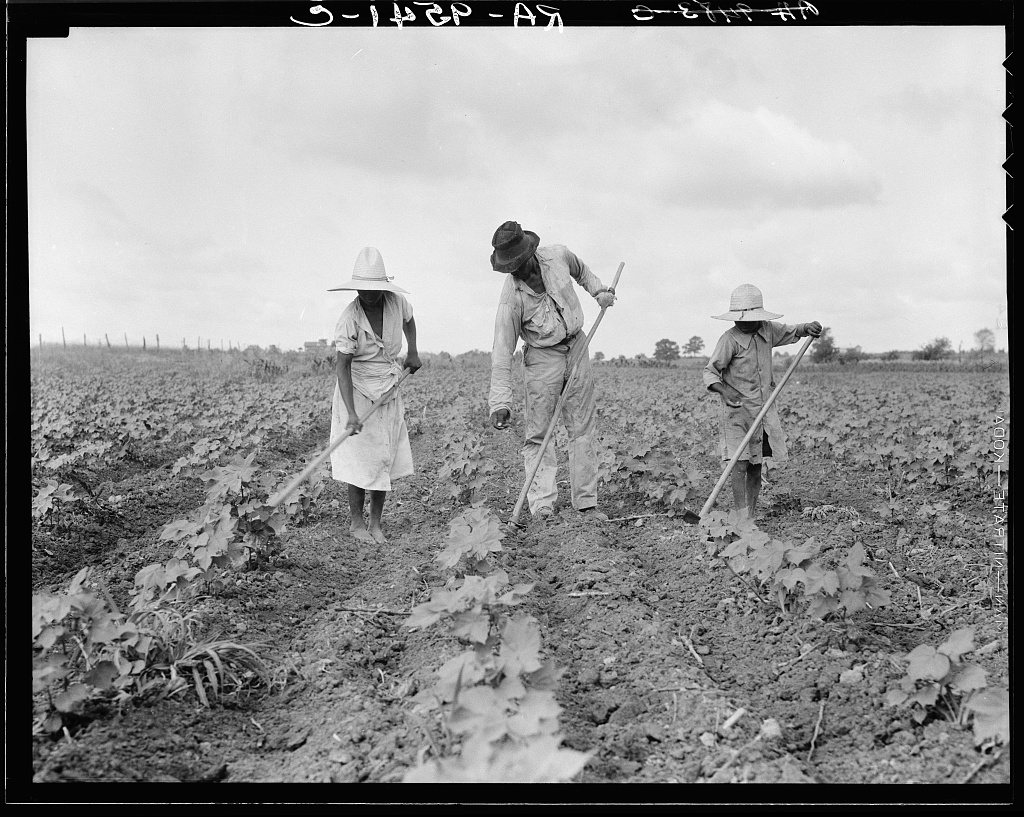
Absent from Shahn’s photograph are the eye contact, conversation, and smiles of recognition that pervade Tanya Berry’s photographs. Unlike For the Hog Killing, 1979, which concludes with a celebratory meal around a common table, the series in 12 Million Black Voices ends with worn-out, eroded land and a dusty grave. Later in the book, Wright reflects on the racist policies and systems that actively undermined and attacked African American agricultural communities in the United States after Abolition: “We . . . were landless upon the land,” he writes, “we . . . barely managed to live as family groups; we . . . needed the ritual and guidance of institutions to hold our atomized lives together in lines of purpose; we . . . had known only relationships to people and not relationships to things; we . . . had never belonged to any organizations except the church and burial societies; we . . . had our personalities blasted with two hundred years of slavery and had been turned loose to shift for ourselves. . .” The result, Wright observes, was that from “1890 to 1920, more than 2,000,000 of us left the land.” Still, Wright notes that more than half of all African Americans tilled the soil in 1940; of those, three quarters farmed as sharecroppers or day laborers with no titled connection to the land they worked.
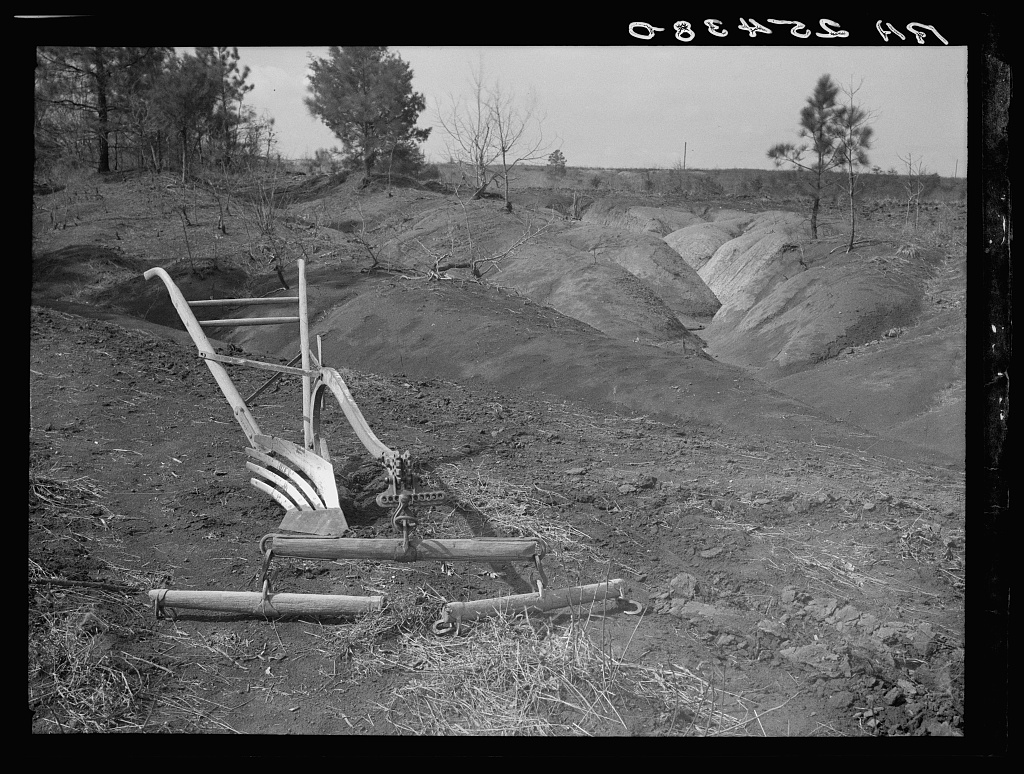
Racism still undermines and threatens African American agricultural communities, making the type of neighborly agricultural cooperation that Berry captures in For the Hog Killing, 1979, rare and difficult. In his 1989 essay, “Racism and the Economy,” Wendell Berry reflects on the dispossession of Black farmers, noting that between 1920 and 1988 the number of black-owned farms fell from 916,000 to 30,000 and that the number of black-owned acres under cultivation decreased from fifteen million to just three million. More recently, Van R. Newkirk II observes in his devastating 2019 Atlantic article, “The Great Land Robbery,” that economic change, white racism, and local white power have “dispossessed 98 percent of black agricultural landowners in America.”
Perhaps the appealing vision of neighborliness that For the Hog Killing, 1979 presents, and the image of agricultural community that it provides, can challenge those of us who are encouraged by the book to channel our memory into the practice of hope. Perhaps this portrayal of a sustaining, provisioning, convivial community will have a more lasting effect on viewers than did the images of butchering that I saw on the campus quad and beside the Christmas tree. If so, may it inspire us to make our future communities, especially our agricultural and rural communities, more just, more openhearted, and less socially distant than those that characterized the 400 years that preceded this spring and summer of national reckoning.

